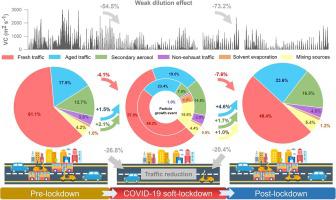当前位置:
X-MOL 学术
›
Environ. Int.
›
论文详情
Our official English website, www.x-mol.net, welcomes your feedback! (Note: you will need to create a separate account there.)
A traffic-induced shift of ultrafine particle sources under COVID-19 soft lockdown in a subtropical urban area
Environment International ( IF 11.8 ) Pub Date : 2024-04-12 , DOI: 10.1016/j.envint.2024.108658 Tse-Lun Chen , Ta-Chih Hsiao , Albert Y. Chen , Kuo-En Chang , Tzu-Chi Lin , Stephen M. Griffith , Charles C.-K. Chou
Environment International ( IF 11.8 ) Pub Date : 2024-04-12 , DOI: 10.1016/j.envint.2024.108658 Tse-Lun Chen , Ta-Chih Hsiao , Albert Y. Chen , Kuo-En Chang , Tzu-Chi Lin , Stephen M. Griffith , Charles C.-K. Chou

|
During the unprecedented COVID-19 city lockdown, a unique opportunity arose to dissect the intricate dynamics of urban air quality, focusing on ultrafine particles (UFPs) and volatile organic compounds (VOCs). This study delves into the nuanced interplay between traffic patterns and UFP emissions in a subtropical urban setting during the spring-summer transition of 2021. Leveraging meticulous roadside measurements near a traffic nexus, our investigation unravels the intricate relationship between particle number size distribution (PNSD), VOCs mixing ratios, and detailed vehicle activity metrics. The soft lockdown era, marked by a 20–27% dip in overall traffic yet a surprising surge in early morning motorcycle activity, presented a natural experiment. We observed a consequential shift in the urban aerosol regime: the decrease in primary emissions from traffic substantially amplified the role of aged particles and secondary aerosols. This shift was particularly pronounced under stagnant atmospheric conditions, where reduced dilution exacerbated the influence of alternative emission sources, notably solvent evaporation, and was further accentuated with the resumption of normal traffic flows. A distinct seasonal trend emerged as warmer months approached, with aromatic VOCs such as toluene, ethylbenzene, and xylene not only increasing but also significantly contributing to more frequent particle growth events. These findings spotlight the criticality of targeted strategies at traffic hotspots, especially during periods susceptible to weak atmospheric dilution, to curb UFP and precursor emissions effectively. As we stand at the cusp of widespread vehicle electrification, this study underscores the imperative of a holistic approach to urban air quality management, embracing the complexities of primary emission reductions and the resultant shifts in atmospheric chemistry.
中文翻译:

亚热带城市地区 COVID-19 软封锁期间交通引起的超细颗粒源变化
在史无前例的 COVID-19 城市封锁期间,出现了一个独特的机会来剖析城市空气质量的复杂动态,重点关注超细颗粒 (UFP) 和挥发性有机化合物 (VOC)。本研究深入探讨了 2021 年春夏季过渡期间亚热带城市环境中交通模式与 UFP 排放之间的微妙相互作用。利用交通枢纽附近的细致路边测量,我们的调查揭示了颗粒数尺寸分布 (PNSD) 之间的复杂关系、VOC 混合比例以及详细的车辆活动指标。软封锁时代的特点是总体交通量下降了 20-27%,但清晨摩托车活动却出现惊人的激增,这是一个自然的实验。我们观察到城市气溶胶状况发生了相应的变化:交通一次排放的减少大大放大了老化颗粒和二次气溶胶的作用。这种转变在停滞的大气条件下尤其明显,其中稀释度的降低加剧了替代排放源的影响,特别是溶剂蒸发,并且随着正常交通流量的恢复而进一步加剧。随着温暖月份的临近,出现了明显的季节性趋势,甲苯、乙苯和二甲苯等芳香族挥发性有机化合物不仅增加,而且还显着导致更频繁的颗粒生长事件。这些发现凸显了在交通热点地区采取有针对性的策略的重要性,特别是在易受大气稀释影响的时期,以有效遏制超细颗粒物和前体排放。当我们正处于广泛的车辆电气化的风口浪尖时,这项研究强调了对城市空气质量管理采取整体方法的必要性,包括初级减排的复杂性以及由此产生的大气化学变化。
更新日期:2024-04-12
中文翻译:

亚热带城市地区 COVID-19 软封锁期间交通引起的超细颗粒源变化
在史无前例的 COVID-19 城市封锁期间,出现了一个独特的机会来剖析城市空气质量的复杂动态,重点关注超细颗粒 (UFP) 和挥发性有机化合物 (VOC)。本研究深入探讨了 2021 年春夏季过渡期间亚热带城市环境中交通模式与 UFP 排放之间的微妙相互作用。利用交通枢纽附近的细致路边测量,我们的调查揭示了颗粒数尺寸分布 (PNSD) 之间的复杂关系、VOC 混合比例以及详细的车辆活动指标。软封锁时代的特点是总体交通量下降了 20-27%,但清晨摩托车活动却出现惊人的激增,这是一个自然的实验。我们观察到城市气溶胶状况发生了相应的变化:交通一次排放的减少大大放大了老化颗粒和二次气溶胶的作用。这种转变在停滞的大气条件下尤其明显,其中稀释度的降低加剧了替代排放源的影响,特别是溶剂蒸发,并且随着正常交通流量的恢复而进一步加剧。随着温暖月份的临近,出现了明显的季节性趋势,甲苯、乙苯和二甲苯等芳香族挥发性有机化合物不仅增加,而且还显着导致更频繁的颗粒生长事件。这些发现凸显了在交通热点地区采取有针对性的策略的重要性,特别是在易受大气稀释影响的时期,以有效遏制超细颗粒物和前体排放。当我们正处于广泛的车辆电气化的风口浪尖时,这项研究强调了对城市空气质量管理采取整体方法的必要性,包括初级减排的复杂性以及由此产生的大气化学变化。



























 京公网安备 11010802027423号
京公网安备 11010802027423号